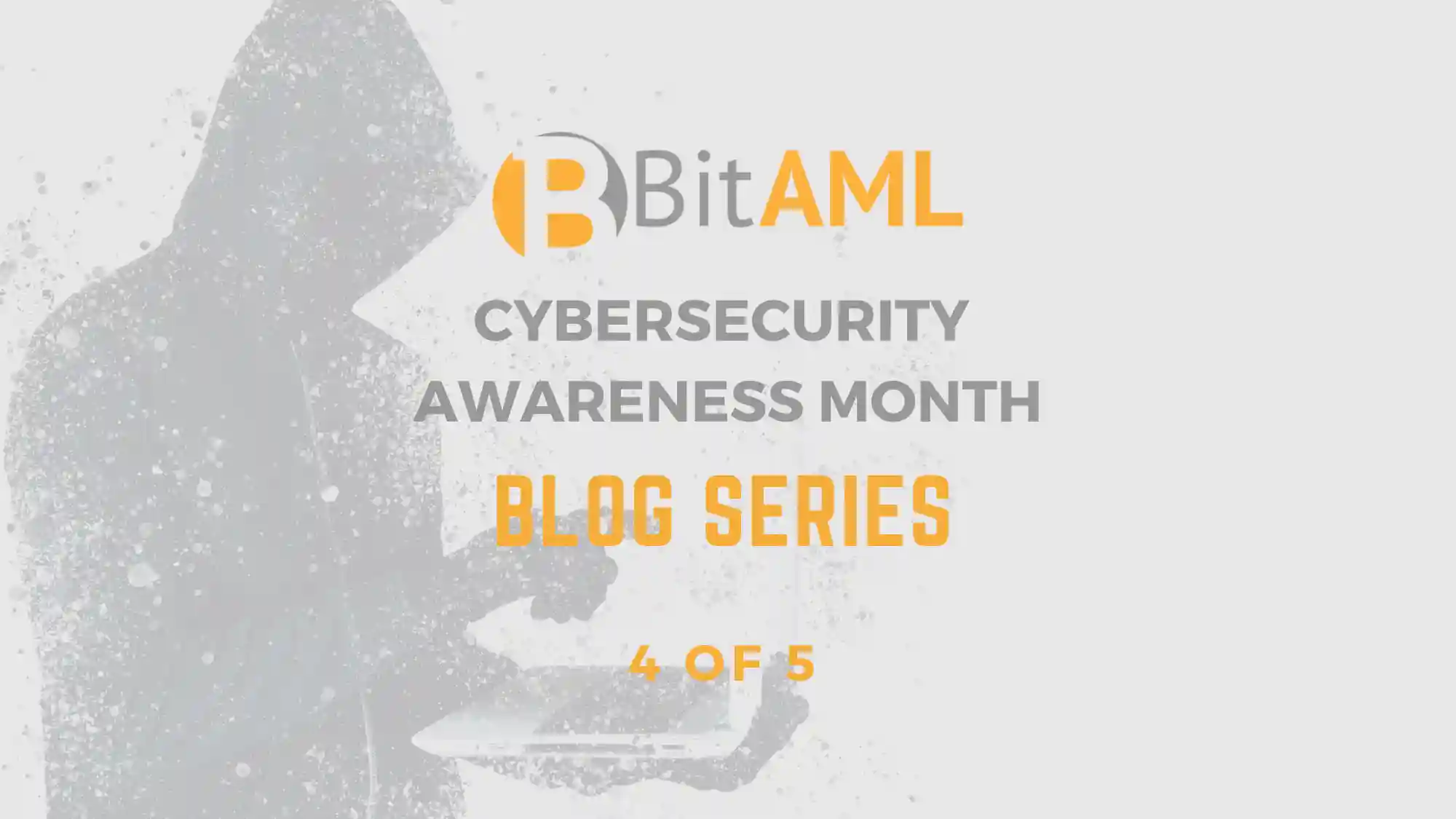October is Cybersecurity Awareness Month in the United States, and BitAML is committed to spreading knowledge and awareness about online security. Throughout this month, our blog posts will provide valuable insights, practical tips, and real-world perspectives to help individuals and organizations reduce online risks.
Previous articles in Cybersecurity Awareness Month Series:
Blog 1 of 5: Navigating Cybersecurity Regulations, Policies & Procedures for Crypto Companies
Blog 2 of 5: Apex Cybersecurity Means Fortifying Your Business with the Best
In the digital world, cyber threats have rapidly evolved, presenting unparalleled challenges to businesses globally. Ransomware, a notable malefactor, has alarmingly evolved, partly attributed to advancements in Artificial Intelligence (AI), forging a necessity to reevaluate cybersecurity strategies comprehensively.
The Escalating Threat of Ransomware Attacks
 The cyber realm trembles under the weight of increasingly sophisticated ransomware attacks, heralding an era where data abduction and ransom demands have burgeoned into a formidable and omnipresent threat. In recent times, ransomware has evolved, transcending its earlier iterations to embody a more sophisticated and deleterious form of cyber malevolence. These malicious software applications, once a mere nuisance, have transformed, employing intricate algorithms and clandestine infiltration strategies to besiege data, rendering it inaccessible until a financial ransom is paid.
The cyber realm trembles under the weight of increasingly sophisticated ransomware attacks, heralding an era where data abduction and ransom demands have burgeoned into a formidable and omnipresent threat. In recent times, ransomware has evolved, transcending its earlier iterations to embody a more sophisticated and deleterious form of cyber malevolence. These malicious software applications, once a mere nuisance, have transformed, employing intricate algorithms and clandestine infiltration strategies to besiege data, rendering it inaccessible until a financial ransom is paid.
Ransomware attacks have proliferated at an alarming rate, targeting entities across a multitude of sectors. In a haunting testament to its pervasive reach, the annual Cybersecurity Ventures report predicts that by 2023, businesses will fall victim to a ransomware attack every 11 seconds, underscoring an escalating crisis of global proportions. Such attacks, manifested in myriad forms, from phishing emails laced with malevolent payloads to exploiting network vulnerabilities, incessantly evolve, deftly sidestepping antiquated defense mechanisms and leaving a trail of operational havoc in their wake.
The infiltration strategies of modern ransomware have become insidiously refined. Moving beyond mere data encryption, contemporary attacks often incorporate a two-pronged assault: firstly encrypting data and demanding a ransom, and secondly, threatening the release of sensitive data into the public domain should the demands not be met—a tactic known as “double dipping.” This modus operandi not only inflicts operational paralysis but also holds the organization’s reputation hostage, coercing entities into capitulating to the financial demands of malefactors.
Moreover, the evolution of Ransomware as a Service (RaaS), wherein cybercriminal syndicates offer ransomware for lease or sale to aspiring attackers, has democratized access to advanced cyber weaponry, expanding the threat landscape exponentially. This alarming development has enabled even technically unsophisticated actors to launch potent attacks, exacerbating the ransomware epidemic and instigating a reevaluation of cybersecurity paradigms.
This burgeoning cyber plague necessitates a paradigm shift towards more dynamic and adaptive cybersecurity postures. Organizations, now more than ever, are implored to deepen their understanding of the ransomware landscape, scrutinizing evolving threat vectors and crafting fortified defenses to safeguard against the inexorably advancing wave of cyber extortion.
The Double Impact of Financial and Reputational Damage
Embarking on a somber exploration of ransomware impacts, the immediate financial fallout from an attack is undeniably cataclysmic for businesses. Victims often find themselves ensnared in a dire quandary: to pay the ransom and potentially regain data access or resist payment and risk permanent data loss, both scenarios often entailing crippling financial expenditures for data recovery, system fortification, and possibly, ransom payment. Recent statistical data indicates a stark surge in the fiscal magnitude of ransomware attacks, with ransoms skyrocketing and collateral financial damages following suit.
Moreover, the financial toll is often shadowed by a more insidious repercussion: reputational damage. Stakeholder trust, once a steadfast pillar for businesses, can crumble in the aftermath of a ransomware attack, as customers, investors, and partners may question the integrity and security of their association with the compromised entity. The reverberations of reputational harm can echo long after the incident, often manifesting as diminished customer loyalty, wary investors, and a tarnished brand image. Real-world instances, such as the notorious attacks on Garmin and Colonial Pipeline, illuminate the tangible and enduring repercussions of ransomware attacks, revealing a labyrinth of financial and reputational devastations that beleaguered organizations must navigate through.
In this intricate tableau of fiscal and reputational impacts, it becomes paramount for businesses to not only comprehend the profound implications of ransomware attacks but also to preemptively strategize against potential incidents, thereby safeguarding both their financial vitality and reputational standing.
The Emergence of AI in Cybercriminal Tactics
Artificial Intelligence (AI), revered for its potential to drive innovation and efficiency across numerous sectors, has unfortunately found a sinister ally in the world of cybercrime. Cybercriminals exploit AI to enhance their capabilities, leveraging machine learning algorithms to automate and optimize attack strategies, thereby crafting threats that are not only potent but also highly scalable. Furthermore, AI facilitates the creation of malware and ransomware that can adapt to various defense mechanisms, augmenting the breadth and depth of potential cyber-attacks, and navigating through cybersecurity defenses with unsettling agility and efficacy.
While the Typologies are only limited to the imagination of the criminal mind, here are a handful of notable examples…
Automated Social Engineering Attacks through AI
- Personalized Phishing: Leveraging AI to scrape individuals’ social media and other online presences to create hyper-personalized phishing messages that are more likely to deceive and exploit the recipient.
- Behavioral Mimicry: Developing AI algorithms that learn and mimic the online behaviors and writing styles of individuals to convincingly impersonate them in communications, thereby duping recipients into unauthorized actions or revealing confidential information.
Exploitation of Biometric Systems
- Biometric Spoofing: Using AI to synthesize biometric data (like facial recognition or voice patterns) to gain unauthorized access to secure systems or to create deepfakes that can mislead, defraud, or damage reputations.
- Anomaly Masking: Deploying AI to subtly manipulate malicious network traffic or activities to mimic legitimate ones, thereby evading anomaly detection systems and enabling covert operations on target networks.
Enhancing Malware Capabilities
- Adaptive Malware: Crafting malware that employs AI to analyze the environment it infiltrates, adapt to defensive measures, and modify its behavior to ensure persistence and evasion from detection tools.
- Automated Exploit Generation: Utilizing AI to automatically identify vulnerabilities in software and generate exploits, significantly reducing the time window between vulnerability disclosure and exploit availability.
AI-Driven Ransomware Attacks
- Target Optimization: Implementing AI to analyze potential targets for ransomware attacks, prioritizing them based on likely ROI, ability to pay, and potential impact on the target, thereby maximizing profit and impact.
- Decoy Generation: Utilizing AI to generate convincing decoy files during ransomware attacks that waste victim recovery efforts and increase pressure to pay ransoms.
Meet AI-Enhanced malware, the new cyber super weapon
Malware, historically known for its disruptiveness and potential for destruction, reaches new peaks of threat in its AI-enhanced iterations. AI-powered malware is not bound by static attributes; instead, it learns, adapts, and evolves, ensuring its longevity and increased difficulty to detect and neutralize. Notably, AI enables malware to analyze and understand the environments they infiltrate, making intelligent decisions on how to propagate, whom to target, and when to strike, thereby increasing the overall impact and success rate of the attacks. This formidable alliance of AI and malware poses an insidious threat that demands an equally sophisticated and agile defense mechanism.
Defense Against The Machine – Tackling AI-Powered Cyberattacks
Developing defenses against AI-powered cyberattacks necessitates a thorough understanding of the advanced capabilities and methodologies employed by modern cybercriminals. These AI-driven attacks are adept at identifying and exploiting vulnerabilities, often circumventing traditional defense mechanisms with frightening precision. In response, cybersecurity defenses must adapt to utilize AI in a parallel manner, employing machine learning algorithms to predict, identify, and mitigate evolving threats in real-time, thereby crafting a dynamic defense that continuously evolves in anticipation of the next cyber onslaught. The realm of cybersecurity now witnesses an unparalleled digital arms race, wherein defensive and offensive AI technologies are perpetually locked in a battle of wits and innovation.
Business Defense Strategies Against AI-Powered Ransomware
In the battlefield against AI-powered ransomware, businesses must deploy a multifaceted strategy that intertwines both preventative and remedial measures, ensuring robust security and swift recovery should an attack occur. Proactive measures, such as employing AI-driven security solutions, engaging in continuous threat monitoring, and conducting regular security audits, forge a formidable initial line of defense. Furthermore, organizations must also devise a comprehensive incident response plan, ensuring that in the wake of an attack, the recovery is swift, data loss is minimized, and financial and reputational impacts are mitigated. Engaging in continuous employee training and fostering a cybersecurity-centric organizational culture also serve as pivotal steps toward constructing a holistic defense against the nefarious specter of AI-enhanced ransomware.
Ransomware, particularly that which is supercharged by AI, unequivocally stands as one of the most formidable cyber threats to contemporary digital entities. The intersectionality of immediacy and efficacy in cybersecurity efforts has transcended from being a strategic advantage to a bare essential for survival in the digital domain.
Your brand means more than money, it’s about trust and legacy, two things that aren’t for sale. Give us 20 minutes and we’ll help you get started with your cybersecurity.
In light of the aforementioned, businesses are encouraged to promptly scrutinize and fortify their cybersecurity postures. Readers are welcomed to delve deeper into the nuances of cybersecurity through the resources provided, and we invite further discourse in the comment section to propagate awareness and collective knowledge.
Dedicated cybersecurity is pivotal in the cryptocurrency space. BitAML provides unrivaled expertise in crafting top-tier security consulting and compliance solutions tailored to cryptocurrency endeavors. Drawing from a vast understanding of cryptocurrency systems, our team is poised to elevate your security and compliance protocols. Contact us today to see how BitAML can redefine and enhance your cybersecurity and compliance framework.


